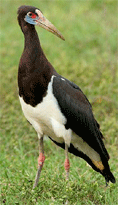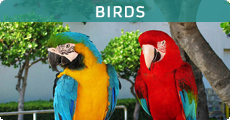Abdim's Storck's
 This
bird belongs to the stork's family and is considered to be the smallest
species in the family. The abdim's stork is characterized with a
long neck and a pair of long legs. The wingspan of the bird is very long
and broad when compared to its size.
This
bird belongs to the stork's family and is considered to be the smallest
species in the family. The abdim's stork is characterized with a
long neck and a pair of long legs. The wingspan of the bird is very long
and broad when compared to its size.
The bird comes with a kind of brownish black feathers and they also
have a tinge of purple and pink coloration in their feathers. But the
feathers under the abdomen and the ones under the tail are white in color.
They possess powerful wings which make them soar remarkably. Another notable
feature in the appearance of the bird is its bill, which is large and
pointed.
These birds live in the eastern and southern parts of Africa, but during
the breeding season they move to the north of the equator. They like to
live near the grasslands, areas of cultivation, and areas with water,
but they can also live in areas of dry conditions.
Their diet includes large insects, swarming locusts and caterpillars,
sometimes they feed on grasshoppers, crickets, even mice and small aquatic
animals become a part of their diet.
The male and the female bird grow up to a same length; both are 2 1/2-3
feet long, but the male bird weighs
slightly more than the female bird. They have a broad wing span of about
2-3 feet.
 According to the myths storks bring good luck and this is because these
birds migrate from November to March, on their way they pass through east
Africa, where rains would be pouring and finally they reach Africa in
the months of April or may, again during these months Africa would be
experiencing rains. So these storks are nicknamed as rain bringers.
According to the myths storks bring good luck and this is because these
birds migrate from November to March, on their way they pass through east
Africa, where rains would be pouring and finally they reach Africa in
the months of April or may, again during these months Africa would be
experiencing rains. So these storks are nicknamed as rain bringers.
The abdim's stork is considered to be gregarious as they travel
in huge communities, they land only for feeding. They are also called
as expert feeders because they find their prey quickly and consume them
fast.
Abdim's Storks are majestic breeders, often nesting jointly in
trees or crags. The gatherings can vary from a few pairs to several thousand,
and are often found with other species of storks. These storks also nest
in the roofs of local huts, which is often taken as positive sign by the
populace since it is assumed that they bring good luck. They usually lay
a clasp of 2-3 eggs, but sometimes only 1. The chicks fledge at around
50-60 days.












